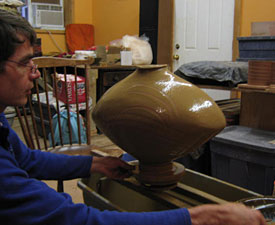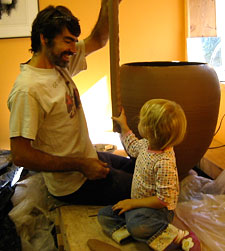Willi Singleton: Leading the Slow Clay Movement
 Willi at work in his studio.
Willi at work in his studio.Photograph courtesy of Willi Singleton
Willi Singleton, owner of Pine Creek Pottery is proponent of "slow clay," in which he cultivates unprocessed and locally sourced materials to create functional and beautiful stoneware enhanced by copper glazes. Influenced greatly by Japanese culture, his work reflects both his enjoyment of the art form as well as a sense of place it was created in.
He uses several antique tools and processes, including a manual kick-wheel to form the pots and an organic wood ash glaze for his finishes. The resulting aesthetic makes every one of his pots a reflection of his home and of the human and natural energy that transforms raw matter into sophisticated earthenware.
Singleton uses a very simple recipe for his glazes, then adds "spices" of copper carbonate, iron or other material for color. Using wood, bamboo and other ashes from abundant materials harvested in his valley, he creates his basic glaze recipe with a little bit of silica. Because the wood-fired kiln can create a number of results from the amount of heat and amount of oxygen, a copper glaze, for example, can appear on a spectrum of gray to green.
Every ingredient in Singleton's ceramics process originates as closely as possible from his home in Hawk Mountain. He digs clay himself from the foot of a local stream, harvests fallen wood to fire his handmade earthen kiln, invites friends and locals two times a year to help him stoke the kiln fires, and processes the wood ashes into natural glazes.
Singleton's studio is based near a privately run bird sanctuary in southeastern Pennsylvania, named Hawk Mountain. It was here that his parents bought a self- sustaining farm in the 1940s that was transformed into his home and workshop, affording him access to 15 fertile acres between the Delaware and Susquehanna Rivers.
As an apprentice in Japan in the 80s, he studied under Tappo Narui. A third generation master, Narui not only taught Singleton new pottery forms and inherited techniques, but also a way of life married to a philosophy of pleasure and purpose. Singleton reflects, "Narui would say, 'Take it easy and enjoy what you are doing. Treat people well.' It's not just about making pottery and becoming a successful artist, you should live your life well, with meaning."
 Willi with his daughter Samantha.
Willi with his daughter Samantha. Photograph courtesy of Willi Singleton
He calls his style of ceramics "slow clay," a comparison to the slow food movement. He describes it in terms of bread. American pre-mixed clay is the "ceramic equivalent of Wonderbread," Singleton says. "Its over-processed, homogenized wheat loses all of its nutrients-the unevenness and life being milled out of it."
Singleton goes on to say that commercial clays are similarly homogenized, eventually pulverized to resemble flour, then reconstituted. In this way, potters can buy different kinds of clay that perform as they expect them to.
But Singleton prefers to keep contact with the origin of his natural materials, and over many years of experimentation has learned how to work with his clay. He discovered the clay on his land as a happy accident, and became determined to work with it despite its lack of plasticity. "I found it very difficult to work with. It didn't stretch at all and it was very grainy. It's kind of like someone who's been raised on puffy white Wonderbread suddenly having a full whole grain loaf." Eventually he landed upon a 50-50 marriage of his backyard clay with a non-refractory clay 75 miles away in Maryland, and this has been his clay mixture ever since.
Despite all the work he dedicates to remaining a local potter, he says he wouldn't have it any other way. "I like having my hands in mud, throwing my feet on the kickwheel," he says. "It's a very elemental process."
Also in this Issue:
- ChemArt: Beautiful Memories Etched in Brass
- Willi Singleton: Leading the Slow Clay Movement
- Courtney Fischer Jewelry: Expressions of Color and Texture
- Debby & Joel Arem: Three Ring Circuits
- Art Institute of Chicago Announces Major Acquisition of an Early 17th Century Copper Painting
